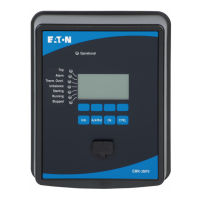1.3 Modules, Settings, Signals and Values
The EMR-3MP0 is a digital protection device that holds various data in its internal
memory. Some data is meant to be changed by the user to adapt the functionality to the
respective application, other data types are set by the device during run-time and are
therefore read-only from the user's perspective.
All settings, device planning and checking the state of signals at run-time can be done:
• Directly at the device; or
• By way of the PowerPort-E software application.
Modules
The rmware of the EMR-3MP0 can be thought of being sub-divided in several
independent function blocks. Throughout our Technical Documentation, we are talking of
“modules” (or sometimes of “functions”). Every protection function, for example, is a
module of its own, every communication protocol is a module, there is even a general
protection module (named »Prot«) that interacts with all specic protection modules.
It is important to know that every parameter and every signal and value is always part of
exactly one module (even if the module name might not be displayed on the panel for the
sake of simplicity).
Modules can interact with each other, either because this is a xed implemented part of
the rmware, or if the user has assigned some signal of a module to a parameter (that
becomes a module input this way). An example for a xed implemented interaction is
that the trip signal of any protection module always triggers the trip signal of the
general »Prot« module.
Some modules exist in several (identical) instances, which can be activated and
congured independently. These can be used to have several protection stages. However,
there is one fundamental dierence to the EMR-3MP0: The functionality of all instances
(of a particular module) is always identical (except for the dierences that are due to
dierent setting values).
There is the following naming convention: If several instances of a
module »Module« exist, then these are named »Module[1]«, »Module[2]«, … (or, as a
short form for descriptions: »Module[x]«).
Types of Settings, Signals and Values
Settings (also called parameters)
• Parameters are data that can be modied by the user, to adapt the functionality of
the respective application. (See also ╚═▷ “Parameter Settings”.)
PowerPort-E users can save all settings to a le. This is a le with a lename of the
form *.ErPara. It can be (re-)loaded at any later time, and the setting values
contained therein can be transferred to some (other) EMR-3MP0 protection device.
(For details see the PowerPort-E manual.)
(Remark: There are a few exceptions, where a particular setting is always stored
within the device and never saved to a *.ErPara le. This is the case if it is not
28 www.eaton.com EMR-3MP0
1 EMR‑3MP0 Motor Protection Relay
1.3 Modules, Settings, Signals and Values

